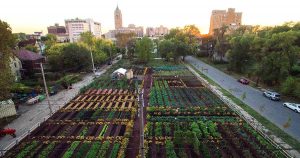Jennifer Diaz
SOS: ComAlt, Seminar Pre-Write Week 2
17 January 2017
Word Count: 247
Passages:
“Hart estimates that for every dollar spent on food, 15 to 20 cents represent the raw commodities used in that product. The rest represents advertising, transportation and fuel, labor, real estate, and other inputs….’The organic, local food, and community· garden movements bring back the idea that the main cost we would like to see in our food is the agricultural product underneath,” Hart explains, and the excitement in his voice is audible. “As we look at those food systems, we bring back the percentage that is related to the underlying commodity’.” (Newman 2013: 11, 14)
“But this sense of dietary immersion in ones own elements, of burning from within, of the self indistinguishable from the “strong solution” of its surroundings …” “There are the eaters, and then there are the eaten; similarly, there are the eaters, and then there are the hungry … black bodies and subjects in these encounters fight back, and bite back, both in the white imaginary and in domestic manuals and novels produced by black authors. Although excluded from the biopolitical, nation-building imperatives of a mostly white reform movement that nonetheless often aligned itself with abolition, black authors and citizens insisted on their relevance and centrality to national narratives of bodily belonging.” (Tompkins 2012: 7,8,9)
News Media Context:
‘Agrihood’ project focuses on farm-to-table in Detroit
 Detroit officials announced a partnership that will help transform a long-vacant apartment building into a community center and cafe to anchor its growing agricultural campus. The project is being touted as the nation’s first urban “agrihood,” an alternative neighborhood that’s built around the farm-to-table model featured mainly in rural and suburban settings.
Detroit officials announced a partnership that will help transform a long-vacant apartment building into a community center and cafe to anchor its growing agricultural campus. The project is being touted as the nation’s first urban “agrihood,” an alternative neighborhood that’s built around the farm-to-table model featured mainly in rural and suburban settings.
http://smartgrowth.org/agrihood-project-focuses-farm-table-detroit/
Discussion:
Newmans book gave us numbers concerning how much of our money actually goes towards the nourishment we seek. Why should people who cannot afford to own their own homes be forced to support this middle person who is in the way of us eating our corn flakes? Tompkins points out that in the images of black folks that white people depict, they usually always fight back and bite back. Despite their oppression they always “burn from within” (Tompkins 2012: 7) Later in the passage Tompkins goes on to say how in all of the films and books and even in day-to-day life, black people in the nineteenth century had a sharp tongue (as sharp as their master would allow.) I was thinking about how black people are portrayed in our modern media this still seemed relevant. Most roles for black bodies in the entertainment world are the funny guy or the angry sassy girl. Then it got me thinking about how black people fight back without using direct verbal attacks. Like the way Black Panthers was formed or the abortion clinic of Chicago in the 1960’s. I learned about the Detroit “agrihood” recently; another way to fight back. It got me thinking about how else we fight back without literally fighting. Whose idea was this “agrihood” anyway? Was it someone who had melanin? Does that matter in the long run if people are being fed real food for prices that make sense? I am not sure.
people are portrayed in our modern media this still seemed relevant. Most roles for black bodies in the entertainment world are the funny guy or the angry sassy girl. Then it got me thinking about how black people fight back without using direct verbal attacks. Like the way Black Panthers was formed or the abortion clinic of Chicago in the 1960’s. I learned about the Detroit “agrihood” recently; another way to fight back. It got me thinking about how else we fight back without literally fighting. Whose idea was this “agrihood” anyway? Was it someone who had melanin? Does that matter in the long run if people are being fed real food for prices that make sense? I am not sure.
Citations:
Newman, Kara. (2013). The Secret Financial Life of Food: From Commodities Markets to Supermarkets. New York: Columbia University Press.
Tompkins, Kyla Wazana. (2012). Racial Indigestion: Eating Bodies in the 19th Century. NewYork: New York University Press.
Images:
http://www.crainsdetroit.com/article/20161201/NEWS/161209999/michigan-urban-farming-initiative-grows-plan-for-agrihood-in-detroit
Hey hey hey Jen, Shani here.
Let it be known that I have not read the seminar material, so I will only be responding to a portion of your post.
I never really thought about inequities as a verb tied to eating, but in a way I suppose to have nourishment we must take nourishment from somewhere else, as seen in hunting/gathering, supermarket shopping, and/or stealing. There’s always been the haves and have-nots and depicting this struggle as a challenge of food is a very simple and visceral way to get the point across. In relation to the “agrihood”, to supply ones location with food grown on-site is (I believe) a peaceful form of closing the have/have-not discussion. By not participating in the commodification of food, one can step away from the power struggle entirely.
Or can they? If growing your own food is a way to maintain independence then you’re actually drawing an arbitrary line because you’re not taking in the externalities which brought the seeds to you, brought the mulch, the grid powered water to your irrigation, etc. Agrihood is definitely a step in the right direction in that it does lower the cost of transportation from growers to eaters, however I’d be wary of the false sense of security this can incur as the path doesn’t end there. Do you remember the six levels of a socially conscience farm (were you there in EcoAg that quarter? Maybe not)? Stage one is the farm as it is, stage six (or was it five) is the farm at its best, when it is creating socially just environments and following ethical practices. All this is to say, I’m glad the agrihood exists, I’m worried it might be too import-dependent and would love to see it in the context of a community supplying its own mulch, compost, seeds, etc.
Furthermore, as I’m interested in urban agriculture, it’s one of my focuses this quarter to research what urban soils are like, specifically regarding toxins. What is the toxin threshold people are willing to bio-accumulate in themselves in order to grow local food and maintain independence? How can we relate the various levels of toxins to location and socio-economic factors? How much will it cost a socio-economically impaired community to regain and maintain independence, specifically regarding “clean” imported soil?
Thanks for sharing your post.
Shani A